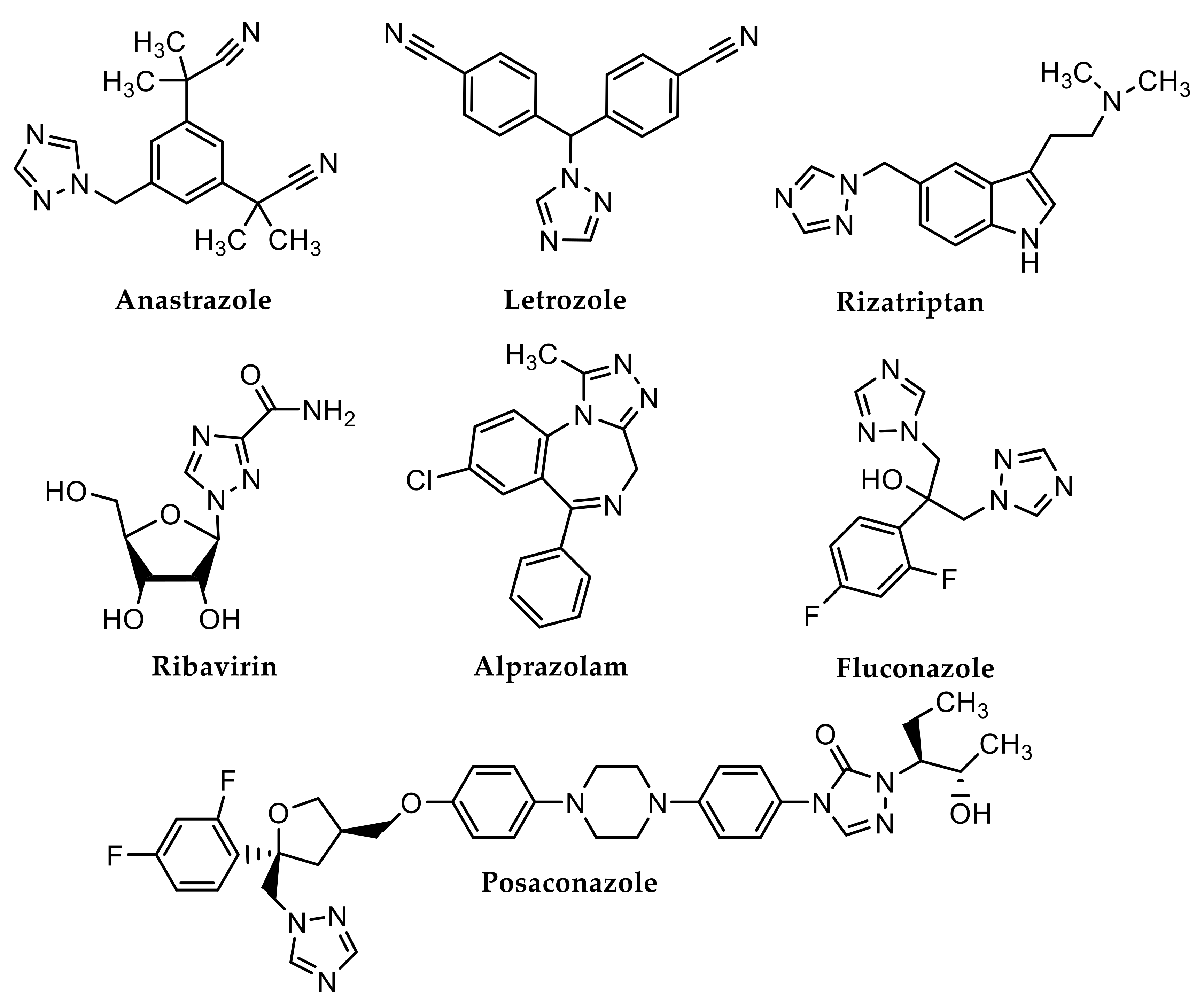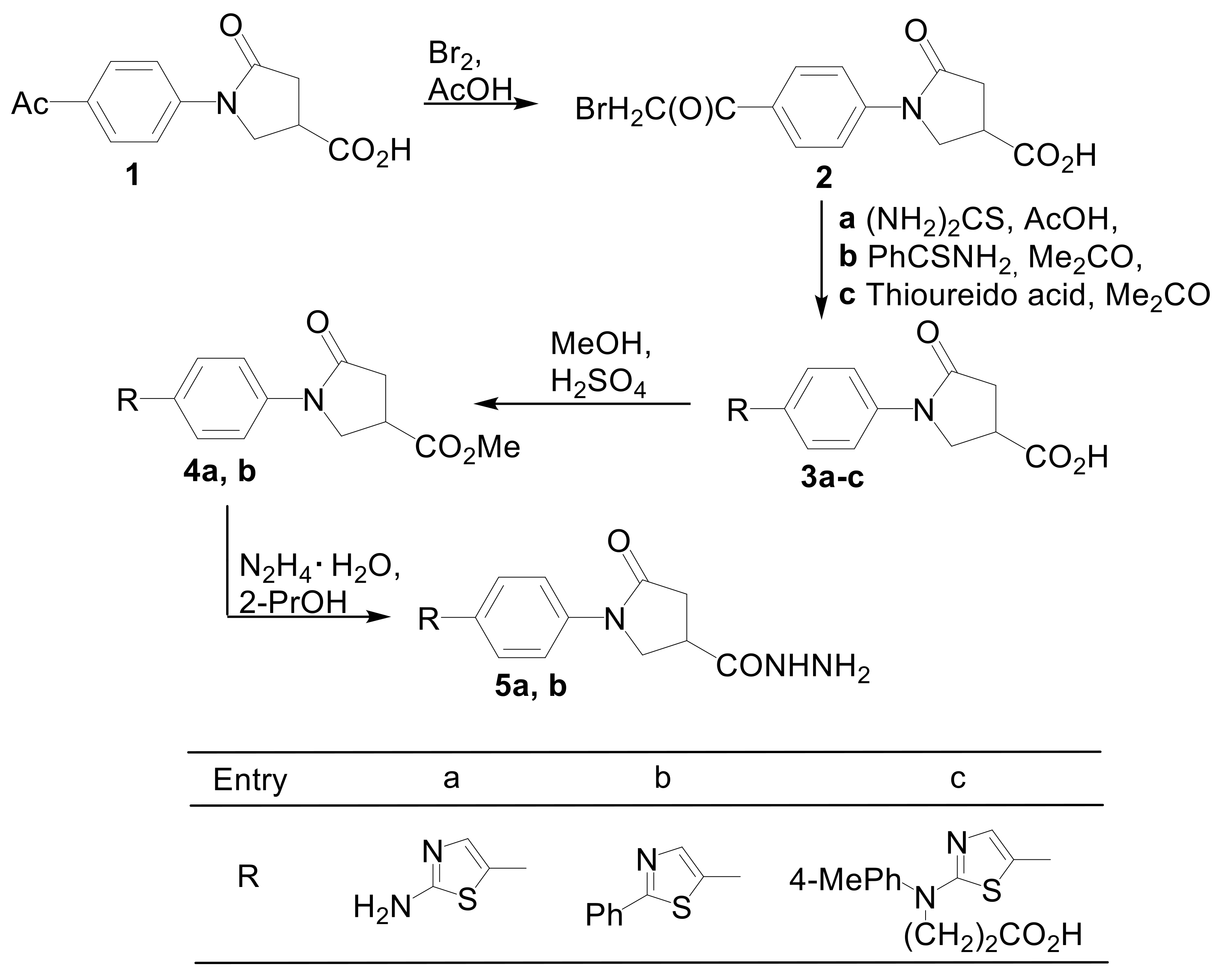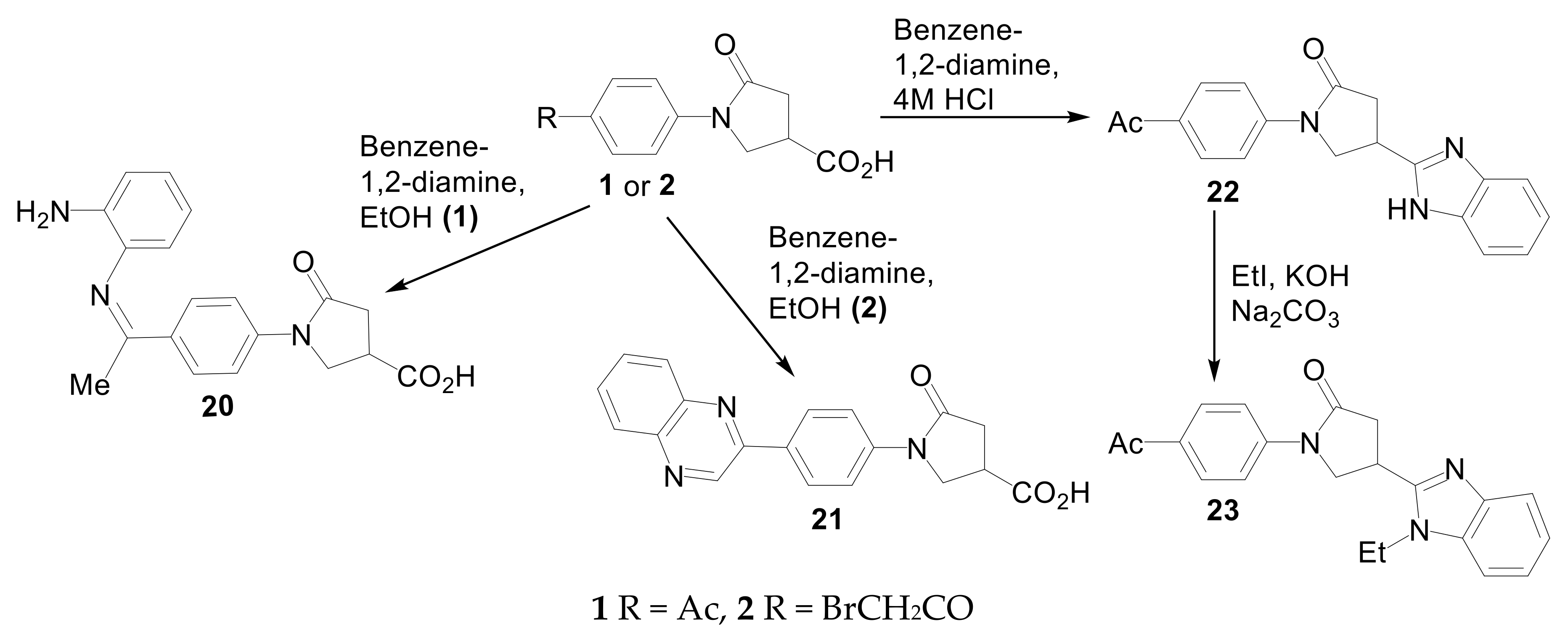Synthesis, Characterization and Bioassay of Novel Substituted 1-(3-(1,3-Thiazol-2-yl)phenyl)-5-oxopyrrolidines
Abstract
1. Introduction
2. Results and Discussion
2.1. Chemistry
2.2. Biological Activity
3. Materials and Methods
3.1. Synthesis
3.1.1. General Procedure for the Preparation of Esters 4a,b
3.1.2. General Procedure for the Preparation of Hydrazides 5a,b
3.1.3. General Procedure for the Preparation of Hydrazones 6–12
3.1.4. General Procedure for the Preparation of Hydrazones 11b, 12b
3.1.5. General Procedure for the Preparation of Pyrroles 13a,b
3.2. Biological Activity
4. Conclusions
Supplementary Materials
Author Contributions
Funding
Conflicts of Interest
References
- Salem, M.A. Synthesis of New Thiazole, Bithiazolidinone and Pyrano[2,3-d]thiazole Derivatives as Potential Antimicrobial Agents. Croat. Chem. Acta. 2017, 90, 7–15. [Google Scholar] [CrossRef]
- Bondock, S.; Fouda, A.M. Synthesis and evaluation of some new 5-(hetaryl)thiazoles as potential antimicrobial agents. Synth. Commun. 2018, 48, 561–573. [Google Scholar] [CrossRef]
- Abd Elhameed, A.A.; El-Gohary, N.S.; El-Bendary, E.R.; Shaaban, M.I.; Bayomi, S.M. Synthesis and biological screening of new thiazolo[4,5-d]pyrimidine and dithiazolo[3,2-a:5′,4′-e]pyrimidinone derivatives as antimicrobial, antiquorum-sensing and antitumor agents. Bioorg. Chem. 2018, 81, 299–310. [Google Scholar] [CrossRef] [PubMed]
- Nastasa, C.; Tiperciuc, B.; Duma, M.; Benedec, D.; Oniga, O. New Hydrazones Bearing Thiazole Scaffold: Synthesis, Characterization, Antimicrobial, and Antioxidant Investigation. Molecules 2015, 20, 17325–17338. [Google Scholar] [CrossRef] [PubMed]
- Annadurai, S.; Martinez, R.; Canney, D.J.; Eidem, T.; Dunman, P.M.; Abou-Gharbia, M. Design and synthesis of 2-aminothiazole based antimicrobials targeting MRSA. Bioorg. Med. Chem. Lett. 2012, 22, 7719–7725. [Google Scholar] [CrossRef] [PubMed]
- El-Sayed, N.N.E.; AL-Balawi, N.A.; Alafeefy, A.M.; AL-Shaikh, M.A.; Khan, K.M. Synthesis, Characterization and Antimicrobial Evaluation of some Thiazole-Derived Carbamates, Semicarbazones, Amides and Carboxamide. J. Chem. Soc. Pak. 2016, 38, 358–368. [Google Scholar]
- Sharshira, E.M.; Hamada, N.M.M. Synthesis, Characterization and Antimicrobial Activities of Some Thiazole Derivatives. Am. J. Org. Chem. 2012, 2, 69–73. [Google Scholar] [CrossRef]
- Grybaitė, B.; Vaickelionienė, R.; Stasevych, M.; Komarovska-Porokhnyavets, O.; Kantminienė, K.; Novikov, V.; Mickevičius, V. Synthesis and antimicrobial activity of novel thiazoles with reactive functional groups. Chem. Select. 2019, 4, 6965–6970. [Google Scholar]
- Surineni, G.; Gao, Y.; Hussain, M.; Liu, Z.; Lu, Z.; Chhotaray, C.; Islam, M.M.; Adnan Hameed, H.M.; Zhang, T. Design, synthesis, and in vitro biological evaluation of novel benzimidazole tethered allylidenehydrazinylmethylthiazole derivatives as potent inhibitors of Mycobacterium tuberculosis. Med. Chem. Commun. 2019, 10, 49–60. [Google Scholar] [CrossRef]
- Pattan, S.R.; Krishna Reddy, V.V.; Manvi, F.V.; Desai, B.G.; Bhat, A.R. Synthesis of N-3-(4-(4-chlorophenyl thiazole-2-yl)(2-(amino)methyl)quinazoline-4(3H)-one and their derivatives for antitubercular activity. Indian J. Chem. 2006, 45, 1778–1781. [Google Scholar]
- Kesicki, E.A.; Bailey, M.A.; Ovechkina, Y.; Early, J.V.; Alling, T.; Bowman, J.; Zuniga, E.S.; Dalai, S.; Kumar, N.; Masquelin, T.; et al. Synthesis and Evaluation of the 2-Aminothiazoles as Anti-Tubercular Agents. PLoS ONE 2016, 11, 1–25. [Google Scholar] [CrossRef] [PubMed]
- Pieroni, M.; Wan, B.; Cho, S.; Franzblau, S.G.; Costantino, G. Design, synthesis and investigation on the structure-activity relationships of N-substituted 2-aminothiazole derivatives as antitubercular agents. Eur. J. Med. Chem. 2014, 72, 26–34. [Google Scholar] [CrossRef] [PubMed]
- Fathalla, W. Syntheses and reactions of methyl [3-(4-phenyl-thiazol-2-yl)-thioureido]alkanoates and related compounds. Arkivoc 2008, 12, 245–255. [Google Scholar]
- Dawood, K.M.; Eldebss, T.M.; El-Zahabi, H.S.; Yousef, M.H. Synthesis and antiviral activity of some new bis-1,3-thiazole derivatives. Eur. J. Med. Chem. 2015, 102, 266–276. [Google Scholar] [CrossRef]
- Stankova, I.; Chuchkov, K.; Shishkov, S.; Kostova, K.; Mukova, L.; Galabov, A.S. Synthesis, antioxidative and antiviral activity of hydroxycinnamic acid amides of thiazole containing amino acid. Amino Acids 2009, 37, 383–388. [Google Scholar] [CrossRef]
- Hargrave, K.D.; Hess, F.K.; Oliver, J.T. N-(4-substituted-thiazolyl)oxamic acid derivatives, a new series of potent, orally active antiallergy agents. J. Med. Chem. 1983, 26, 1158–1163. [Google Scholar] [CrossRef]
- Brzezińska, E.; Stolarska, J.; Sobanska, A. A structure-activity relationship study of thiazole derivatives with H1-Antihistamine activity. 2011, 68, 677–686. Acta Pol. Pharm. 2011, 68, 677–686. [Google Scholar]
- Hammad Elgazwy, A.S.; Nassar, E.; Zaki, M.Y. Synthesis, Biological Evaluation of Some 2,3-dihydropyrazoles and Thiazoles as Anti-inflammatory and Antibacterial Agents. Org. Chem. Curr. Res. 2012, 1, 1000112. [Google Scholar] [CrossRef]
- Li, M.; Sim, Y.; Ham, S.W. Discovery of 2-Aminothiazole Derivatives as Antitumor Agents. Bull Korean Chem. Soc. 2010, 31, 1463–1465. [Google Scholar] [CrossRef]
- Harnett, J.J.; Roubert, V.; Dolo, C.; Charnet, C.; Spinnewyn, B.; Cornet, S.; Rolland, A.; Marin, J.-G.; Bigga, D.; Chabrierb, P.-E. Phenolic thiazoles as novel orally-active neuroprotective agents. Bioorg. Med. Chem. Lett. 2004, 14, 157–160. [Google Scholar] [CrossRef]
- Łączkowski, K.Z.; Konklewska, N.; Biernasiuk, A.; Malm, A.; Sałat, K.; Furgała, A.; Dzitko, K.; Bekier, A.; Baranowska-Łączkowska, A.; Paneth, A. Thiazoles with cyclopropyl fragment as antifungal, anticonvulsant, and anti-Toxoplasma gondii agents: synthesis, toxicity evaluation, and molecular docking study. Med. Chem. Res. 2018, 27, 2125–2140. [Google Scholar] [CrossRef]
- Shaquiquzzaman, N.S.; ur Rahman, M.; Arshad, M.F.; Ahsan, W.; Alam, M.S.; Ahmed, S. Synthesis, characterization and antimicrobial evaluation of some new 1,3-thiazole-2,4-diamine derivatives. Acta. Pol. Pharm. 2010, 67, 239–246. [Google Scholar]
- Yonova, P.A.; Stoilkova, G.M. Synthesis and biological activity of urea and thiourea derivatives from 2-aminoheterocyclic compounds. J. Plant Growth Regul. 2005, 23, 280–291. [Google Scholar] [CrossRef]
- Wilkes, M.C.; Lavrik, P.B.; Greenplate, J. Synthesis of N-benzoyl-N-alkyl-2-aminothiazole Heliothis virescens proinsecticides. J. Agric. Food Chem. 1991, 39, 1652–1657. [Google Scholar] [CrossRef]
- EMA/487080/2014. European Medicines Agency. 2014. Available online: https://www.ema.europa.eu/en/documents/overview/sutent-epar-summary-public_en.pdf (accessed on 15 December 2019).
- Le Tourneau, C.; Raymond, E.; Faivre, S. Sunitinib: a novel tyrosine kinase inhibitor. A brief review of its therapeutic potential in the treatment of renal carcinoma and gastrointestinal stromal tumors (GIST). Ther. Clin. Risk Manag. 2007, 3, 341–348. [Google Scholar] [CrossRef] [PubMed]
- Balandis, B.; Ivanauskaitė, G.; Smirnovienė, J.; Kantminienė, K.; Matulis, D.; Mickevičius, V.; Zubrienė, A. Synthesis and structure-affinity relationship of chlorinated pyrrolidinone-bearing benzenesulfonamides as human carbonic anhydrase inhibitors. Bioorg. Chem. 2020, 97, 1–12. [Google Scholar] [CrossRef]
- Vaškevičienė, I.; Paketurytė, V.; Pajanok, N.; Žukauskas, Š.; Sapijanskaitė, B.; Kantminienė, K.; Mickevičius, V.; Zubrienė, A.; Matulis, D. Pyrrolidinone-bearing methylated and halogenated benzenesulfonamides as inhibitors of carbonic anhydrases. Bioorg. Med. Chem. 2019, 27, 322–337. [Google Scholar] [CrossRef]
- Khanage, S.G.; Raju, A.; Mohite, P.B.; Pandhare, R.B. Analgesic Activity of Some 1,2,4-Triazole Heterocycles Clubbed with Pyrazole, Tetrazole, Isoxazole and Pyrimidine. Adv. Pharm. Bull 2013, 3, 13–18. [Google Scholar]
- Goyal, P.K.; Bhandari, A.; Rana, A.C.; Jain, C.B. Synthesis, Characterization and Analgesic Activity of some 4H-1, 2, 4-Triazole Derivatives. Int. J. Chem. Tech. Res. 2010, 2, 1992–1997. [Google Scholar]
- El-Sayed, H.A.; Moustafa, A.H.; Haikal, A.-F.Z. Synthesis, Antiviral, and Antimicrobial Activity of 1,2,4-Triazole Thioglycoside Derivatives. Phosphorus, Sulfur Silicon Relat. Elem. 2013, 188, 649–662. [Google Scholar] [CrossRef]
- Paprocka, R.; Wiese, M.; Eljaszewicz, A.; Helmin-Basa, A.; Gzella, A.; Modzelewska-Banachiewicz, B.; Michalkiewicz, J. Synthesis and anti-inflammatory activity of new 1,2,4-triazole derivatives. Bioorg. Med. Chem. Lett. 2015, 25, 2664–2667. [Google Scholar] [CrossRef] [PubMed]
- Sari, S.; Kaynak, F.B.; Dalkara, S. Synthesis and anticonvulsant screening of 1,2,4-triazole derivatives. Pharmacol Rep. 2018, 70, 1116–1123. [Google Scholar] [CrossRef]
- Khanage, S.G.; Raju, S.A.; Mohite, P.B.; Pandhare, R.B. Synthesis and pharmacological evaluation of some new pyrimidine derivatives containing 1,2,4-triazole. Adv. Pharm. Bull. 2012, 2, 213–222. [Google Scholar] [PubMed]
- Kamel, M.M.; Megally Abdo, N.Y. Synthesis of novel 1,2,4-triazoles, triazolothiadiazines and triazolothiadiazoles as potential anticancer agents. Eur. J. Med. Chem. 2014, 86, 75–80. [Google Scholar] [CrossRef] [PubMed]
- Chelamalla, R.; Venkatesham, A.; Sarangapani, M. Novel water-soluble substituted pyrrolo[3,2-d]pyrimidines: design, synthesis, and biological evaluation as antitubulin antitumor agents. J. Pharm. Res. 2012, 5, 4739–4742. [Google Scholar]
- Gupta, D.; Jain, D.K. Synthesis, antifungal and antibacterial activity of novel 1,2,4-triazole derivatives. J. Adv. Pharm. Technol. Res. 2015, 6, 141–146. [Google Scholar] [CrossRef]
- Tumosienė, I.; Peleckis, A.; Jonuškienė, I.; Vaickelionienė, R.; Kantminienė, K.; Šiugždaitė, J.; Beresnevičius, Z.J.; Mickevičius, V. Synthesis of novel 1,2- and 2-substituted benzimidazoles with high antibacterial and antioxidant activity. Monatsh. Chem. 2018, 149, 577–594. [Google Scholar] [CrossRef]
- Jin, R.; Liu, J.; Zhang, G.; Li, J.; Zhang, S.; Guo, H. Design, Synthesis, and Antifungal Activities of Novel 1,2,4-Triazole Schiff Base Derivatives. Chem. Biodivers. 2018, 15, e1800263–e1800270. [Google Scholar] [CrossRef]
- Zhang, S.L.; Damu, G.L.V.; Zhang, L.; Geng, R.X.; Zhou, C.H. Synthesis and biological evaluation of novel benzimidazole derivatives and their binding behavior with bovine serum albumin. Eur. J. Med. Chem. 2012, 55, 164–175. [Google Scholar] [CrossRef]
- Zhang, H.Z.; Damu, G.L.V.; Cai, G.X.; Zhou, C.H. Design, synthesis and antimicrobial evaluation of novel benzimidazole type of Fluconazole analogues and their synergistic effects with Chloromycin, Norfloxacin and Fluconazole. Eur. J. Med. Chem. 2013, 64, 329–344. [Google Scholar] [CrossRef]
- Voskiene, A.; Mickevicius, V.; Mikulskiene, G. Synthesis and structural characterization of products condensation 4-carboxy-1-(4-styrylcarbonylphenyl)-2-pyrrolidinones with hydrazines. Arkivoc 2007, 15, 303–314. [Google Scholar]
- Quintanilla-Licea, R.; Colunga-Valladares, J.F.; Caballero-Quintero, A.; Rodríguez-Padilla, C.; Tamez-Guerra, R.; Gómez-Flores, R.; Waksman, N. NMR Detection of Isomers Arising from Restricted Rotation of the C-N Amide Bond of N-Formyl-o-toluidine and N,N’-bisFormyl-o-tolidine. Molecules 2002, 7, 662–673. [Google Scholar] [CrossRef]
- Palla, G.; Predieri, G.; Domiano, P.; Vignali, C.; Turner, W. Conformational behavior and E/Z isomerization of N-acyl and N-aroylhydrazones. Tetrahedron. 1986, 42, 3649–3654. [Google Scholar] [CrossRef]
- Syakaev, V.V.; Podyachev, S.N.; Buzykin, B.I.; Latypov, S.K.; Habicher, W.D.; Konovalov, A.I. NMR study of conformation and isomerization of aryl- and heteroarylaldehyde 4-tert-butylphenoxyacetylhydrazones. J. Mol. Struct. 2006, 788, 55–62. [Google Scholar] [CrossRef]
- Mazur, L.; Jarzembska, K.N.; Kami ´nski, R.; Wo´zniak, K.; Pindelska, E.; Zieli ´nska-Pisklak, M. Substituent and solvent effects on intermolecular interactions in crystals of N-acylhydrazone derivatives: Single-crystal X-ray, solid state NMR, and computational studies. Cryst. Growth Des. 2014, 14, 2263–2281. [Google Scholar] [CrossRef]
- Gu, W.; Wu, R.; Qi, S.; Gu, C.; Si, F.; Chen, Z. Synthesis and antibacterial evaluation of new N-acylhydrazone derivatives from dehydroabietic acid. Molecules 2012, 17, 4634–4650. [Google Scholar] [CrossRef]
- Cardoso, L.N.F.; Bispo, M.L.F.; Kaiser, C.R.; Wardell, J.L.; Wardell, S.M.S.V.; Lourenço, M.C.S.; Bezerra, F.A.F.; Soares, R.P.P.; Rocha, M.N.; de Souza, M.V.N. Anti-tuberculosis evaluation and conformational study of N-acylhydrazones containing the thiophene nucleus. Arch. Pharm. Chem. Life Sci. 2014, 347, 432–448. [Google Scholar] [CrossRef]
- Voskiene, A.; Mickevicius, V. Products from condensation of 1-(3(4)-acetylphenyl)-4-carboxy-2-pyrrolidinones with o-phenylenediamine and their properties. Chem. Heterocycl. Compd. 2007, 43, 1379–1384. [Google Scholar] [CrossRef]
- Lopez-Oviedo, E.; Aller, A.I.; Martín, C.; Castro, C.; Ramirez, M.; Pemán, J.M.; Cantón, E.; Almeida, C.; Martín-Mazuelos, E. Evaluation of Disk Diffusion Method for Determining Posaconazole Susceptibility of Filamentous Fungi: Comparison with CLSI Broth Microdilution Method. Antimicrob. Agents Chemother. 2006, 50, 1108–1111. [Google Scholar] [CrossRef][Green Version]
- Goodson, B.; Ehrhardt, A.; Ng, S.; Nuss, J.; Johnson, K.; Giedlin, M.; Yamamoto, R.; Krebber, A.; Ladner, M.; Giacona, M.B.; et al. Characterization of Novel Antimicrobial Peptoids. Antimicrob. Agents Chemother. 1999, 43, 1429–1434. [Google Scholar] [CrossRef]
- Peleckis, A.; Anusevičius, K.; Šiugždaitiugė, J.; Mickevičius, V. Nucleophilic ring opening of 1,4-disubstituted 2-pyrrolidones with hydrazine. Synthesis of azoles with a high antibacterial activity. Chemija 2018, 29, 135–144. [Google Scholar] [CrossRef]
Sample Availability: Samples of the compounds are not available from the authors. |




| Compound | Yield, % | Compound | Yield, % | Compound | Yield, % |
|---|---|---|---|---|---|
| 1 | 86 | 7a | 90 | 14b | 54 |
| 2 | 95 | 7b | 69 | 15b | 86 |
| 3a | 62 | 8a | 62 | 16b | 90 |
| 3b | 43 | 8b | 89 | 17b | 76 |
| 3c | 82 | 9b | 82 | 18b | 67 |
| 4a | 62 | 10b | 75 | 19b | 88 |
| 4b | 71 | 11b | 99 | 20 | 82 |
| 5a | 81 | 12b | 96 | 21 | 81 |
| 5b | 65 | 13a | 57 | 22 | 92 |
| 6a | 90 | 13b | 92 | 23 | 88 |
| 6b | 92 | - | - | - | - |
| Compound | Gram-Positive Bacteria Strains | Gram-Negative Bacteria Strains | ||||||||||
|---|---|---|---|---|---|---|---|---|---|---|---|---|
| S. aureus | B. cereus | L. monocytogenes | P. aeruginosa | E. coli | S. enterica enteritidis | |||||||
| MIC | MBC | MIC | MBC | MIC | MBC | MIC | MBC | MIC | MBC | MIC | MBC | |
| µg/mL | ||||||||||||
| 3a | 15.6 | 31.25 | 31.25 | 62.5 | 31.25 | 62.5 | 31.25 | 62.5 | 31.25 | 62.5 | 31.25 | 62.5 |
| 3b | 31.25 | 62.5 | 15.6 | 31.25 | 15.6 | 31.25 | 15.6 | 31.25 | 62.5 | 125 | 15.6 | 31.25 |
| 3c | 7.8 | 15.6 | 7.8 | 15.6 | 7.8 | 15.6 | 7.8 | 15.6 | 7.8 | 15.6 | 7.8 | 15.6 |
| 4a | 62.5 | 125 | 31.25 | 62.5 | 31.25 | 62.5 | 31.25 | 62.5 | 31.25 | 62.5 | 31.25 | 62.5 |
| 4b | 15.6 | 31.25 | 15.6 | 31.25 | 15.6 | 31.25 | 15.6 | 31.25 | 15.6 | 31.25 | 15.6 | 31.25 |
| 5a | 31.25 | 62.5 | 31.25 | 62.5 | 31.25 | 62.5 | 31.25 | 62.5 | 31.25 | 62.5 | 31.25 | 62.5 |
| 5b | 7.8 | 15.6 | 7.8 | 15.6 | 7.8 | 15.6 | 7.8 | 15.6 | 7.8 | 15.6 | 7.8 | 15.6 |
| 6a | 31.25 | 62.5 | 31.25 | 62.5 | 31.25 | 62.5 | 31.25 | 62.5 | 31.25 | 62.5 | 31.25 | 62.5 |
| 6b | 15.6 | 31.25 | 15.6 | 31.25 | 15.6 | 31.25 | 15.6 | 31.25 | 15.6 | 31.25 | 15.6 | 31.25 |
| 7b | + | - | 7.8 | 15.6 | 15.6 | 31.25 | + | - | 15.6 | 31.25 | 15.6 | 15.6 |
| 8b | 31.25 | 62.5 | 31.25 | 62.5 | 31.25 | 62.5 | 31.25 | 62.5 | 15.6 | 31.25 | 31.25 | 62.5 |
| 9b | 7.8 | 15.6 | 15.6 | 31.25 | 15.6 | 31.25 | 15.6 | 31.25 | 15.6 | 31.25 | 15.6 | 31.25 |
| 11b | 62.5 | 125 | + | - | 15.6 | 31.25 | 15.6 | 31.25 | 31.25 | 62.5 | 15.6 | 31.25 |
| 12b | 31.25 | 62.5 | 31.25 | 62.5 | 31.25 | 62.5 | 31.25 | 62.5 | 31.25 | 62.5 | 31.25 | 62.5 |
| 13a | 31.25 | 62.5 | 31.25 | 62.5 | 31.25 | 62.5 | 31.25 | 62.5 | 31.25 | 62.5 | 31.25 | 62.5 |
| 13b | 31.25 | 62.5 | 15.6 | 31.25 | 15.6 | 31.25 | 15.6 | 31.25 | 31.25 | 62.5 | 15.6 | 31.25 |
| 14b | 7.8 | 15.6 | 62.5 | 125 | 125 | 250 | 125 | 250 | 125 | 250 | + | - |
| 15b | 7.8 | 15.6 | 7.8 | 15.6 | 7.8 | 15.6 | 7.8 | 15.6 | 7.8 | 15.6 | 7.8 | 15.6 |
| 16b | 7.8 | 15.6 | 7.8 | 15.6 | 7.8 | 15.6 | 7.8 | 15.6 | 7.8 | 15.6 | 7.8 | 15.6 |
| 17b | 15.6 | 31.25 | 15.6 | 31.25 | 15.6 | 31.25 | 15.6 | 31.25 | 15.6 | 31.25 | 15.6 | 31.25 |
| 21 | 62.5 | 125 | 31.25 | 31.25 | 31.25 | 62.5 | - | - | 125 | 125 | 31.25 | 62.5 |
| 22 | 31.25 | 31.25 | 31.25 | 62.5 | - | - | 31.25 | 62.5 | 31.25 | 31.25 | - | - |
| 23 | 15.6 | 31.25 | 31.25 | 62.5 | - | - | 31.25 | 62.5 | 31.25 | 31.25 | - | - |
| C | 62.5 | 125 | ||||||||||
© 2020 by the authors. Licensee MDPI, Basel, Switzerland. This article is an open access article distributed under the terms and conditions of the Creative Commons Attribution (CC BY) license (http://creativecommons.org/licenses/by/4.0/).
Share and Cite
Sapijanskaitė-Banevič, B.; Šovkovaja, B.; Vaickelionienė, R.; Šiugždaitė, J.; Mickevičiūtė, E. Synthesis, Characterization and Bioassay of Novel Substituted 1-(3-(1,3-Thiazol-2-yl)phenyl)-5-oxopyrrolidines. Molecules 2020, 25, 2433. https://doi.org/10.3390/molecules25102433
Sapijanskaitė-Banevič B, Šovkovaja B, Vaickelionienė R, Šiugždaitė J, Mickevičiūtė E. Synthesis, Characterization and Bioassay of Novel Substituted 1-(3-(1,3-Thiazol-2-yl)phenyl)-5-oxopyrrolidines. Molecules. 2020; 25(10):2433. https://doi.org/10.3390/molecules25102433
Chicago/Turabian StyleSapijanskaitė-Banevič, Birutė, Božena Šovkovaja, Rita Vaickelionienė, Jūratė Šiugždaitė, and Eglė Mickevičiūtė. 2020. "Synthesis, Characterization and Bioassay of Novel Substituted 1-(3-(1,3-Thiazol-2-yl)phenyl)-5-oxopyrrolidines" Molecules 25, no. 10: 2433. https://doi.org/10.3390/molecules25102433
APA StyleSapijanskaitė-Banevič, B., Šovkovaja, B., Vaickelionienė, R., Šiugždaitė, J., & Mickevičiūtė, E. (2020). Synthesis, Characterization and Bioassay of Novel Substituted 1-(3-(1,3-Thiazol-2-yl)phenyl)-5-oxopyrrolidines. Molecules, 25(10), 2433. https://doi.org/10.3390/molecules25102433





